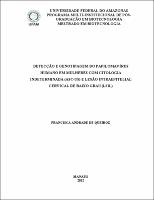| ???jsp.display-item.social.title??? |


|
Please use this identifier to cite or link to this item:
https://tede.ufam.edu.br/handle/tede/2224Full metadata record
| DC Field | Value | Language |
|---|---|---|
| dc.creator | Queiroz, Francisca Andrade de | - |
| dc.creator.Lattes | http://lattes.cnpq.br/8902026816530734 | por |
| dc.contributor.advisor1 | Santos, Cristina Maria Borborema dos | - |
| dc.contributor.advisor1Lattes | http://lattes.cnpq.br/7512612117477966 | por |
| dc.date.available | 2015-04-07 | - |
| dc.date.issued | 2012-06-27 | - |
| dc.identifier.citation | QUEIROZ, Francisca Andrade de. Detecção e genotipagem do papilomavírus humano em mulheres com citologia indeterminada (asc-us) e lesão intraepitelial cervical de baixo grau (lsil).. 2012. 99 f. Dissertação (Mestrado em Biotecnologia) - Universidade Federal do Amazonas, Manaus, 2012. | por |
| dc.identifier.uri | http://tede.ufam.edu.br/handle/tede/2224 | - |
| dc.description.resumo | O Papillomavírus humano (HPV) é reconhecido como o principal fator de risco relacionado do câncer cervical. A identificação de tipos de HPV de alto risco pode auxiliar na prevenção de lesões malignas do colo do útero. Este estudo tem como objetivo determinar e genotipar o HPV em mulheres com resultado citológico de Lesão Intraepitelial de Baixo grau (LSIL) e Células Escamosas Atípicas Significado Indeterminado (ASC-US). Trata-se de um estudo de corte transversal com componente analítico em mulheres atendidas na Fundação Alfredo da Matta - FUAM. As pacientes foram selecionadas a partir do arquivo de exames do Laboratório de Citologia da FUAM no período de janeiro de 2009 a julho de 2011 e solicitadas a comparecer ao ambulatório de DST por meio de busca ativa, a fim de fazer uma nova coleta de material para reavaliação citológica, detecção molecular e genotipagem do HPV. A detecção molecular foi realizada pela técnica de Nested-PCR tendo como alvo a região L1 do capsídeo viral. Os produtos da PCR foram analisados em gel de agarose. Do total de 100 pacientes selecionadas, 70% (70/100) participaram do estudo, sendo que 34 delas tinham resultado citológico de ASC-US e 36 de LSIL. Após reavaliação citológica 8(11,4%) pacientes apresentaram citologia dentro dos limites da normalidade, 33(47,2%) citologia inflamatória, 22(31,4) ASC-US, 6(8,6%) LSIL, 1(1,4%) HSIL. O HPV foi identificado em 28,6% (20/70) das amostras examinadas. Das 20 pacientes HPV-DNA positivas 1 caso apresentou citologia dentro do limite da normalidade, 6 citologia inflamatória, 10 ASC-US, 2 LSIL e 1 caso apresentou HSIL. Após a genotipagem foram identificados os seguintes tipos de HPV: 6, 16, 58, 61, 70, 83, 84 e 85. O HPV mais prevalente com 5 casos em 20 positivos foi o HPV 58. A presença do HPV de alto risco oncogênico destaca a importância de ações voltadas para a prevenção na transmissão desse vírus e no rastreamento das doenças relacionadas, na cidade de Manaus. | por |
| dc.description.abstract | The human papillomavirus (HPV) is recognized as a major risk factor related to cervical cancer. The identification of HPV types of high risk can aid in the prevention of malignant lesions of the cervix. This study aims to determine and genotype HPV in women with a cytological result of ASC-US and LSIL. This is a cross-sectional study with an analytical component in women attended the Fundação Alfredo da Matta - FUAM. The patients were selected from the file examination of the Laboratory of Cytology of FUAM from January 2009 to July 2011 and requested to attend the DST clinic through active search in order to make a new collection of material for revaluation cytological, molecular detection and genotyping of HPV. Molecular detection was performed by Nested-PCR targeting the L1 region of the viral capsid. PCR products were analyzed on an agarose gel. Out of 100 patients selected, 70% (70/100) participated in the study, 34 of them had the cytological result of ASC-US and LSIL of 36. After reevaluation cytological 8 (11.4%) patients had cytology within normal limits, 33 (47.2%) inflammatory cytology, 22 (31.4%) ASC-US, 6 (8.6%) LSIL, 1 (1.4%) HSIL. HPV was identified in 28.6% (20/70) of the samples. Of the 20 patients HPV DNA-positive 1 had cytology within normal limits, 6 inflammatory cytology, 10 ASC-US and 2 LSIL and 1 HSIL. After the genotyping were identified the following HPV types 6, 16, 58, 61, 70, 83, 84 and 85. The most prevalent HPV 25% was HPV 58. The presence of HPV high-risk oncogenic stresses the importance of actions aimed at preventing the transmission of this virus and tracking of diseases in the city of Manaus. | eng |
| dc.format | application/pdf | por |
| dc.thumbnail.url | http://200.129.163.131:8080//retrieve/10059/francisca.pdf.jpg | * |
| dc.language | por | por |
| dc.publisher | Universidade Federal do Amazonas | por |
| dc.publisher.department | Instituto de Ciências Biológicas | por |
| dc.publisher.country | BR | por |
| dc.publisher.initials | UFAM | por |
| dc.publisher.program | Programa de Pós-Graduação em Biotecnologia | por |
| dc.rights | Acesso Aberto | por |
| dc.subject | Citologia | por |
| dc.subject | Papillomavírus humano | por |
| dc.subject | Reação da Polimerase em Cadeia (PCR) | por |
| dc.subject | Cytology | eng |
| dc.subject | Human Papillomavirus | eng |
| dc.subject | Polymerase Chain Reaction (PCR). | eng |
| dc.subject.cnpq | CIÊNCIAS BIOLÓGICAS | por |
| dc.title | Detecção e genotipagem do papilomavírus humano em mulheres com citologia indeterminada (asc-us) e lesão intraepitelial cervical de baixo grau (lsil). | por |
| dc.type | Dissertação | por |
| Appears in Collections: | Mestrado em Biotecnologia | |
Files in This Item:
| File | Description | Size | Format | |
|---|---|---|---|---|
| francisca.pdf | 857.51 kB | Adobe PDF |  Download/Open Preview |
Items in DSpace are protected by copyright, with all rights reserved, unless otherwise indicated.




